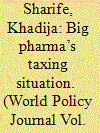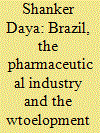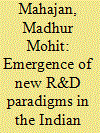|
|
|
Sort Order |
|
|
|
Items / Page
|
|
|
|
|
|
|
| Srl | Item |
| 1 |
ID:
144415


|
|
|
|
|
| Summary/Abstract |
Khadija Sharife analyzed the public disclosures of nine pharmaceutical companies and found that collectively they have dodged paying about $140 billion in taxes by stashing $405 billion in income in offshore tax havens. Sharife also shows that the alleged cost of obtaining a patent trotted out by Big Pharma is the product of artificial expenses and mispricing. Increasingly, it’s public institutions, which are deprived of funding by pharma’s tax avoidance strategies, that overwhelmingly pay for and develop new medicines.
|
|
|
|
|
|
|
|
|
|
|
|
|
|
|
|
| 2 |
ID:
021571


|
|
|
|
|
| Publication |
Jan 2002.
|
| Description |
53-104
|
|
|
|
|
|
|
|
|
|
|
|
|
|
|
|
| 3 |
ID:
157667


|
|
|
|
|
| Summary/Abstract |
The study determines the efficiency of Indian pharmaceutical firms and its determinants in the pre- and post-product patent regime. Overall inefficiency in the industry is higher due to the inefficient conversion of inputs into output rather than through scale inefficiency. The study finds that the Product Patent Act has a negative impact on efficiency. Ownership, capital imports intensity and size variables are positively related with efficiency scores whereas age, time dummy and size square variables are inversely related. The study supports the finding that with an increase in mergers and acquisitions, a movement towards diversifying operations, the use of advanced imported foreign technology, investment in fixed assets and judicious allocation of resources for marketing activities could improve firm performance. For future policy implications, the small firms may either merge into bigger entities or manufacture pharmaceutical products for other companies, so as to raise operational scale and improve capacity utilisation.
|
|
|
|
|
|
|
|
|
|
|
|
|
|
|
|
| 4 |
ID:
110291


|
|
|
|
|
| Publication |
2011.
|
| Summary/Abstract |
India, being a signatory of WTO agreements, has moved from no or partial patent protection to full fledged patent protection. This represents a radical break from the past in which developing countries typically had only weak levels of patent protection. In this context, this research examines the steps involved in development of R&D capabilities in the Indian pharmaceutical firms as a response to strengthening of patent law. This paper analyses the post-TRIPS behaviour of domestic pharmaceutical firms in India with respect to R&D intensification, development of new molecules and enhanced DMF filings. The study establishes that firms in the post WTO era have increased their R&D efforts tremendously and are moving towards the development of advance level process and product R&D capabilities. Such firms have also opted for vigorous DMF filings abroad reflecting qualitative modifications and adjustments in its R&D capabilities in the production of exportables.
|
|
|
|
|
|
|
|
|
|
|
|
|
|
|
|
| 5 |
ID:
111212


|
|
|
|
|
| Publication |
2012.
|
| Summary/Abstract |
The survey aims to explore the attitudes of physicians, nurses, pharmacists, pharmaceutical representatives, and patients from two provinces of Turkey, Nevsehir and Istanbul, in context of ethical conduct within the health services and the relation between the health services and its suppliers, particularly the pharmaceutical industry. Quantitative and qualitative methods were used together. The questionnaire interviews were conveyed to a total of 1540 people and eight focus group discussions to 85 people during April-May 2009. The most common unethical acts in medical practice are "knife payment"/additional informal payment, self-referral, patient discrimination, discrediting other physicians, unnecessary tests-interventions-prescriptions, accepting promotion and demand for personal-household goods, preferring products that come along with promotion, getting cash per box, sponsored vacations in the form of medical congress. Eliminating monetary relationship between the physician and the patient; discouraging close contact of the physician and the healthcare institution with the pharmaceutical industry; implementing commissions in hospitals to supervise physicians for preventing patient discrimination and unnecessary interventions within the framework of good clinical practices; building a supreme board of medical journalism to prevent artificial demand for medical interventions and creation of false hopes, are the proposed precautions for corruption in health services.
|
|
|
|
|
|
|
|
|
|
|
|
|
|
|
|
| 6 |
ID:
152804


|
|
|
|
|
| Summary/Abstract |
This article attempts to examine the impact of mergers and acquisitions (M&A) on export competitiveness of firms in Indian pharmaceutical industry. It finds that the wave of M&A has positive influence on both incidence and extent of export competitiveness. In addition, incidence of exports is positively influenced by market share and efforts towards creating marketing and distribution related complementary assets as well. On the other hand, the extent of export intensity is also higher for firms with larger market share, greater marketing and distribution-related efforts, innovation and foreign technology purchase. However, advertising and financial performance do not cause any significant impact on export competitiveness. It is, therefore, suggested that policies and regulations relating to M&A, innovation and sourcing foreign technology need a fresh look with greater industry-specific flexibilities. There is also a need for integration of different policies and regulations in areas like FDI, intellectual property, and so on.
|
|
|
|
|
|
|
|
|
|
|
|
|
|
|
|
| 7 |
ID:
190156


|
|
|
|
|
| Summary/Abstract |
This paper reports the innovation effect of pharmaceutical industry agglomeration from the perspective of patterns of agglomeration and innovation, by using registration application data for innovative and generic drugs as indicators of pharmaceutical innovation. First, the distribution of the pharmaceutical industry in China is characterized by high agglomeration and low innovation. Second, no significant influence is exerted by regional industrial and development zone agglomeration on the development of innovative drugs in different regions; the effect of the promotion of generic drugs is reflected mainly in the location entropy index. Third, the existence of a crowding effect weakens the effect of the promotion of agglomeration on pharmaceutical innovation and the adverse impact on innovative drugs is significantly greater than the effect on generic drugs. In further research, we explored the bias effect of agglomeration in development zones and the synergistic effects of different agglomeration models. It is difficult to improve the quality of independent innovation by spatial agglomeration. Government-led development zones play a rather limited role in pharmaceutical innovation.
|
|
|
|
|
|
|
|
|
|
|
|
|
|
|
|
| 8 |
ID:
057705


|
|
|
|
|
|
|
|